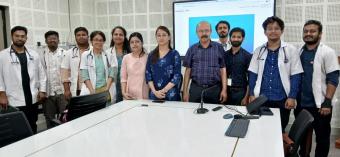Without a doubt, 24 January 2019 will be remembered as a historic day in our hospital, writes Dr. Federico Giner of Luis C. Lagomaggiore Hospital.

Treating approximately 11,000 patients a year, the Luis C. Lagomaggiore Hospital is the second most important public adult hospital in the province of Mendoza, Argentina. However, until the end of 2018, there was no systemic recanalization therapy in place for ischemic stroke patients.
Fortunately, thanks to a strong effort and invaluable support from the Angels Initiative, our hospital staff received a training on how to manage acute ischemic stroke patients for the first time on 18 January 2019.
It was an intense seven-hour day, led by two of the country's top leaders in this subject, Dr. Adolfo Savia and Dr. Cristina Zurrú. The training addressed the main issues inherent in the management of these patients, transmitting both knowledge and real-life experiences.
One of the most important things to highlight was the commitment and support of the hospital staff, as the training was attended by 85 people from various departments including doctors and nurses from the Intensive Care, Neurology, Medical Clinic, Cardiology and Emergency units, as well as laboratory and image technicians, porters, all the way to admins and management staff… all banding together for the common good.
At the end of the training day, we performed a simulation in real time. The stroke team carried out the evaluation and treatment of a dummy stroke patient, achieving a door-to-treatment time of 22 minutes and 33 seconds – a feat which nobody in the hospital could have dreamed of at the time.
But we knew the real test would only come when it’s time to treat a real patient. As it turned out, we did not have to wait long.
It was only six days later when a patient with suspected acute ischemic stroke entered the Emergency Room. His onset of symptoms was 40 minutes ago. The stroke code was activated immediately. Upon arrival at the Neurology area, the patient had already been evaluated by the emergency staff and had two peripheral IV accesses. A rapid evaluation was followed by a brain CT scan, and the patient was immediately transferred to the Intensive Care Unit where they started recanalization treatment.
And so there it was… our first intravenous recanalization therapy with a door-to-treatment time of 41 minutes! This number will certainly improve as the team treat more patients and gain more experience, but certainly not bad for a first real case ever!


Our First Recanalisation Therapy
An Argentinian hospital accomplished their first intravenous recanalisation therapy with a door-to-treatment time of 41 minutes!


